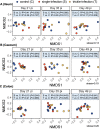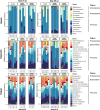Modulation of the porcine intestinal microbiota in the course of Ascaris suum infection
- PMID: 36397169
- PMCID: PMC9673396
- DOI: 10.1186/s13071-022-05535-w
Modulation of the porcine intestinal microbiota in the course of Ascaris suum infection
Abstract
Background: The porcine roundworm Ascaris suum impairs feed conversion and weight gain, but its effects on intestinal microbiota remain largely unexplored.
Methods: Modulation of the intestinal microbiota was assessed in pigs that were infected once with 10,000 A. suum eggs and pigs that received a trickle infection (1000 eggs/day over 10 days), compared with a non-infected control group. Six pigs each were sacrificed per group at days 21, 35 and 49 post-infection (p.i.). Faecal samples taken weekly until slaughter and ingesta samples from different intestinal compartments were subjected to next-generation sequencing of the bacterial 16S rRNA gene.
Results: The results revealed marked differences between the single- and the trickle-infected group. Single infection caused a remarkable but transient decrease in microbial diversity in the caecum, which was not observed in the trickle-infected group. However, an increase in short-chain fatty acid-producing genera in the caecum on day 21 p.i., which shifted to a decrease on day 35 p.i., was common to both groups, possibly related to changes in excretory-secretory products following the parasite's final moult. Faecal microbial interaction networks were more similar between the single-infected and control group than the trickle-infected group. In addition, a lower degree of similarity over time indicated that A. suum trickle infection prevented microbiota stabilization.
Conclusions: These different patterns may have important implications regarding the comparability of experimental infections with natural scenarios characterized by continuous exposure, and should be confirmed by further studies.
Keywords: Ascarids; Intestinal microbiota; Microbiome; Network analysis; Roundworms; Short-chain fatty acids; Trickle infection.
© 2022. The Author(s).
Conflict of interest statement
The authors declare that there are no competing interests.
Figures







Similar articles
-
Distribution of Ascaris suum in experimentally and naturally infected pigs and comparison with Ascaris lumbricoides infections in humans.Parasitology. 1998 Dec;117 ( Pt 6):589-96. doi: 10.1017/s0031182098003382. Parasitology. 1998. PMID: 9881384
-
Changes in porcine nutrient transport physiology in response to Ascaris suum infection.Parasit Vectors. 2021 Oct 14;14(1):533. doi: 10.1186/s13071-021-05029-1. Parasit Vectors. 2021. PMID: 34649607 Free PMC article.
-
Concurrent Ascaris suum and Oesophagostomum dentatum infections in pigs.Vet Parasitol. 1999 Apr 12;82(3):221-34. doi: 10.1016/s0304-4017(99)00007-2. Vet Parasitol. 1999. PMID: 10348102
-
Ascaris suum infection was associated with a worm-independent reduction in microbial diversity and altered metabolic potential in the porcine gut microbiome.Int J Parasitol. 2019 Mar;49(3-4):247-256. doi: 10.1016/j.ijpara.2018.10.007. Epub 2019 Feb 8. Int J Parasitol. 2019. PMID: 30738924
-
Effect of fenbendazole in water on pigs infected with Ascaris suum in finishing pigs under field conditions.Vet Parasitol. 2017 Apr 15;237:1-7. doi: 10.1016/j.vetpar.2017.03.005. Epub 2017 Mar 6. Vet Parasitol. 2017. PMID: 28285891
Cited by
-
Concurrent Ascaris infection modulates host immunity resulting in impaired control of Salmonella infection in pigs.mSphere. 2024 Sep 25;9(9):e0047824. doi: 10.1128/msphere.00478-24. Epub 2024 Aug 14. mSphere. 2024. PMID: 39140728 Free PMC article.
-
Parasite-microbiota interactions: a pathway to innovative interventions for Chagas disease, leishmaniasis, and ascariasis.Future Microbiol. 2025 Feb;20(2):149-161. doi: 10.1080/17460913.2024.2431417. Epub 2024 Nov 22. Future Microbiol. 2025. PMID: 39574234 Review.
-
Acute Ascaris infection impairs the effector functions of natural killer cells in single and Salmonella co-infected pigs.Sci Rep. 2024 Jun 25;14(1):14586. doi: 10.1038/s41598-024-64497-4. Sci Rep. 2024. PMID: 38918457 Free PMC article.
-
Getting around the roundworms: Identifying knowledge gaps and research priorities for the ascarids.Adv Parasitol. 2024;123:51-123. doi: 10.1016/bs.apar.2023.12.002. Epub 2024 Feb 20. Adv Parasitol. 2024. PMID: 38448148 Free PMC article.
References
MeSH terms
Substances
Grants and funding
LinkOut - more resources
Full Text Sources

